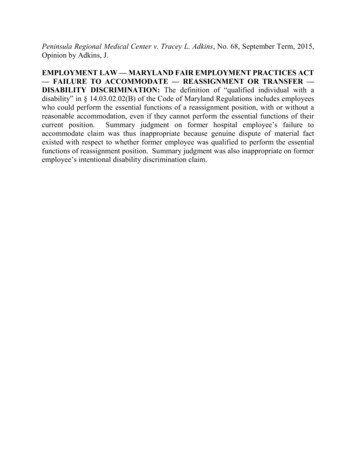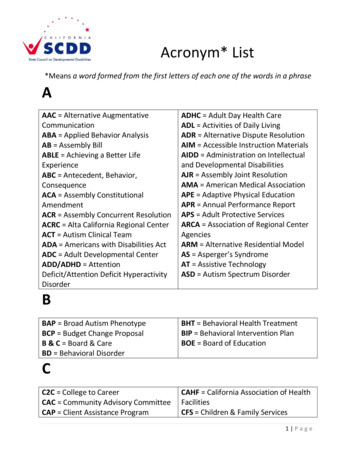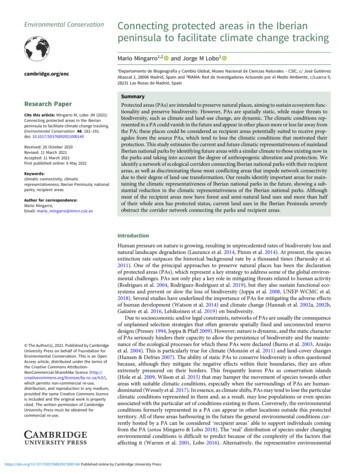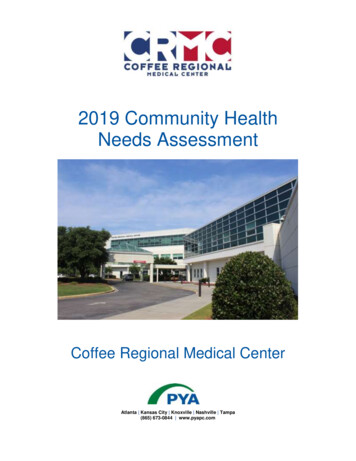
Transcription
Peninsula Regional Medical Center v. Tracey L. Adkins, No. 68, September Term, 2015,Opinion by Adkins, J.EMPLOYMENT LAW — MARYLAND FAIR EMPLOYMENT PRACTICES ACT— FAILURE TO ACCOMMODATE — REASSIGNMENT OR TRANSFER —DISABILITY DISCRIMINATION: The definition of “qualified individual with adisability” in § 14.03.02.02(B) of the Code of Maryland Regulations includes employeeswho could perform the essential functions of a reassignment position, with or without areasonable accommodation, even if they cannot perform the essential functions of theircurrent position. Summary judgment on former hospital employee’s failure toaccommodate claim was thus inappropriate because genuine dispute of material factexisted with respect to whether former employee was qualified to perform the essentialfunctions of reassignment position. Summary judgment was also inappropriate on formeremployee’s intentional disability discrimination claim.
Circuit Court for Wicomico CountyCase No.: 22-C-13-000191Argued: March 8, 2016IN THE COURT OF APPEALSOF MARYLANDNo. 68September Term, 2015PENINSULA REGIONAL MEDICAL CENTERv.TRACEY L. ADKINSBarbera, C.J.*BattagliaGreeneAdkinsMcDonaldWattsHarrell, Glenn T., Jr. (Retired,Specially Assigned),JJ.Opinion by Adkins, J.Filed: May 26, 2016* Battaglia, J., now retired, participated in thehearing and conference of this case while anactive member of this Court; after being recalledpursuant to the Constitution, Article IV, Section3A, she also participated in the decision andadoption of this opinion.
Since its enactment in 1965, the Maryland Fair Employment Practices Act(“FEPA”), Maryland Code (1984, 2014 Repl. Vol.), State Government Article (“SG”)§ 20-601 et seq., has been an important statutory protection of employee civil rights. FEPAprohibits discrimination in employment on the basis of an “individual’s race, color,religion, sex, age, national origin, marital status, sexual orientation, gender identity, geneticinformation, or disability.” SG § 20-606. In this case, we address FEPA’s grant ofprotection to disabled individuals. Specifically, we primarily consider an employer’s dutyto reasonably accommodate a qualified individual with a disability.FACTS AND LEGAL PROCEEDINGSTracey L. Adkins1 (“Adkins”) began her career at Peninsula Regional MedicalCenter (“PRMC”), a hospital located in Salisbury, Maryland, around March 2005. She wasfirst employed as a storekeeper in the Materials Management Department, which is, in part,responsible for inventorying and stocking medical supplies and equipment. In this role,Adkins delivered supplies to various floors of the hospital, organized supplies in the supplyroom, and checked expiration dates of materials. Six months later, she was transferred toInventory Control, more commonly known as the “Cath Lab,” as an inventory controlassistant. This position was also in the Materials Management Department. Adkins heldthis position until September 2010, when the position was “cut.” She then transferred back1The Respondent is no relation to the author of this opinion.
to the storekeeper position, which she held until her termination on February 25, 2012—the event generating the underlying lawsuit.2In April 2011, Adkins went to PRMC’s emergency room after experiencing pain inher groin area and took a few days off from work. When Adkins returned to work, shecontinued to experience pain but managed to complete her tasks. Adkins was ultimatelydiagnosed with a tear in the joint of her left hip as well as a deformation in her hip socket.She was scheduled to have surgery in August 2011 and notified her supervisors. She alsofilled out paperwork to obtain leave under the Family and Medical Leave Act (“FMLA”).3The FMLA paperwork indicated that her leave would begin on August 25, 2011 and thatshe would return to work on or about October 6, 2011. In a letter dated August 11, 2011,PRMC approved Adkins’s FMLA leave request. In this letter PRMC explained that her12-week leave under the FMLA would expire on November 17, 2011 and that so long asshe returned by that date, she would be returned to her job or an equivalent one. PRMCalso advised Adkins in this letter that she would have to obtain a work evaluation from theEmployee Health Office before resuming work. Adkins continued working full-time untilshe underwent surgery in August 2011. In the months leading up to her surgery, Adkins2The storekeeper position was renamed Supply Chain Operations Assistant in 2011,but the duties remained essentially the same.3The Family and Medical Leave Act (“FMLA”) is a federal law guaranteeingeligible employees 12 weeks of unpaid leave each year. 29 U.S.C. § 2612 (2012).Although the FMLA creates a private right of action against employers who “interfere with,restrain, or deny” the exercise of rights provided in the statute, Id. §§ 2615, 2617, Adkinsdoes not allege that Peninsula Regional Medical Center (“PRMC”) violated the FMLA.2
began applying for other positions at PRMC, including Patient Services Rep – MedicalGroup.4Following the surgery, Adkins’s pain intensified and her doctors advised her thatthe time for recovery could range from six months to a year. On October 3, 2011, whilestill out on FMLA leave, Adkins met with James Bunk (“Bunk”), a supervisor who wasthe supply chain operations manager of the Materials Management Department. Sheinformed him that she was meeting her surgeon on October 10 for a follow-up appointmentand that she hoped to learn, at that time, when she could return to work. After the October10 appointment, Adkins received a letter from her physician advising her that she wouldbe unable to return to work until November 7, 2011.Adkins then delivered thisdocumentation to Bunk and PRMC’s Employee Health Office.On November 7, 2011, Adkins returned to work as scheduled and met with a nursein the Employee Health Office. She told the nurse that she was still in pain and would beunable to fulfill her job responsibilities on that day. She explained that she experiencedincreased pain when bending, lifting, and squatting, and that she would not be able to standfor long periods of time. An “Employee Charting Note” for this date states that “[a]llparties” agreed that Adkins could not return to work. It also reflects that Adkins had “beeneducated on FMLA and to start looking at job postings,” and that Adkins reported havingapplied for the “core tech position.”4Adkins also applied for Aide – Physical Therapy, CNA Trainee, Coder AbstractorII, Coordinator – Emergency Admitting, Parking Attendant, Registrar – Outpatient,Representative – Billing/Collection – Medical Group, Representative – Patient Account,and Service Desk IT-Technician before her surgery.3
Adkins returned to her doctor on November 10 and received a medical reportindicating she could return to work under “light duty.” That same day, she brought theform to PRMC’s Employee Health Office. The form stated that she was restricted to“[s]edentary [w]ork: [l]ifting 10 pounds maximum and occasionally lifting and/or carryingsmall articles and occasional walking or standing.” The Employee Health Office toldAdkins “that her unit can not [sic] accommodate her restrictions.” After her surgery andbefore her termination, Adkins applied for several different positions, including PatientServices Rep – Medical Group and Core Technician.5 She also emailed Scott Phillips,director of the Materials Management Department, and Laura McIntyre, Operations RoomMaterials Manager, asking to be considered for an inventory control coordinator position,writing:I was informed that there is now an open position for InventoryControl [Coordinator] in the Cath Lab. With my prior positionin the Cath Lab as the [inventory control] assistant I waswondering if I would be considered for the position. I am stillreleased under Doctors orders under sedentary work but [from]prior knowledge of the job I know that the job is mostlysedentary and I do have the experience and know how for theposition[.]She was not hired for any of these positions.On or around November 17—the day Adkins’s 12-week FMLA leave was set toexpire—PRMC granted her an additional 14 weeks of leave until February 2012. PRMCencouraged her to apply to open positions, but did not identify any specific positions.5Adkins also applied to the following positions: Clerk – Postal, Monitor Technician,Operating Room Core Technician, CNA – Trainee, Coder Abstractor I, and Representative– Billing/Collection – Medical Group.4
During this time, Adkins learned that her storekeeper position had been filled. On January12, 2012, Adkins went back to her doctor for an appointment and received another medicalreport form, which maintained the “light duty” work restrictions.6 Adkins testified in herdeposition that she also gave this note to PRMC.On February 25, 2012, at the end of the 14-week extended leave, Adkins wasterminated. Adkins applied to four more positions after her termination, but was not hiredfor any of these positions.In February 2013, Adkins filed a three-count complaint against PRMC in the CircuitCourt for Wicomico County under FEPA, alleging intentional disability discriminationbased on actual disability, intentional disability discrimination based on being regarded ashaving a disability, and failure to accommodate. PRMC thereafter filed a motion forsummary judgment.7 In May 2014, the Circuit Court issued an order and opinion grantingsummary judgment in favor of PRMC. Adkins appealed the Circuit Court’s ruling as todisability discrimination based on actual disability and failure to accommodate, but did not6The form was dated January 12, 2011, but all parties agree that the actual year was2012. Additionally, the doctor checked both the box stating that Adkins “may return topre-injury job without restriction” and the box indicating the same sedentary workrestriction checked off on the November 10, 2011 medical report form. Adkins understoodthis note to mean that she was still limited to sedentary work.7PRMC filed its first motion for summary judgment in January 2014, but Adkinsfiled an amended complaint several days later. In light of Adkins’s amended complaint,PRMC filed an amended motion for summary judgment in March 2014, which is thesubject of this appeal.5
challenge the trial court’s decision on disability discrimination based on being regarded ashaving a disability.The Court of Special Appeals, however, reversed the Circuit Court’s grant ofsummary judgment on Adkins’s disability discrimination based on actual disability claimand her reasonable accommodation claim. The intermediate appellate court ruled that theevidence contained in the record reflected genuine disputes of material fact as to theseclaims. PRMC appealed and we granted its Petition for Writ of Certiorari. PRMCpresented two questions for review,8 which we simplify into the following questions:(1)Does the definition of “qualified individual with adisability” include employees who could perform the essentialfunctions of a reassignment position, with or without areasonable accommodation, even if they cannot perform theessential functions of their current position?(2)Did the Court of Special Appeals err in reversing theCircuit Court’s grant of summary judgment in favor of PRMC?8In its Petition for Writ of Certiorari, PRMC presented the following questions:(1) Is an employee required under Maryland’s FairEmployment Practices Act to show that she is a “qualifiedindividual with a disability,” namely that she can perform theessential functions of a relevant job with or without areasonable accommodation, before an employer has a duty toprovide a reasonable accommodation?(2) May a plaintiff prevail on a disability discrimination orfailure to accommodate claim where that employee failed toengage in the interactive process with the employer?6
Because we answer yes as to question one and no as to question two, we shall affirm thejudgment of the Court of Special Appeals and remand for further proceedings. Additionalfacts shall be included as necessitated by our discussion of the issues.STANDARD OF REVIEWA circuit court may grant a motion for summary judgment if there is no dispute asto any material fact and the moving party is entitled to judgment as a matter of law.Maryland Rule 2-501(f). “The court is to consider the record in the light most favorable tothe non-moving party and consider any reasonable inferences that may be drawn from theundisputed facts against the moving party.” Mathews v. Cassidy Turley Md., Inc., 435 Md.584, 598 (2013). When a circuit court’s grant of summary judgment hinges on a questionof law, not a dispute of fact, we review whether the circuit court was legally correct withoutaccording deference to that court’s legal conclusions. Id.DISCUSSIONThere are relatively few appellate decisions interpreting Maryland’s FEPA. On theother hand, the federal courts have provided “substantial guidance” on the interpretationand application of federal disability legislation. Barbara T. Lindemann et al., EmploymentDiscrimination Law 13-7 (5th ed. 2012). Because FEPA is modeled after federal law, seeHaas v. Lockheed Martin Corp., 396 Md. 469, 503–04 (2007) (Battaglia, J., dissenting), abrief overview of federal disability law is necessary.The intermediate appellate court’s outline of federal law is instructive and meritsquoting at length. The court wrote:7
Title VII of the Civil Rights Act of 1964 established a broadprohibition of workplace discrimination on the grounds of race,color, religion, sex, and national origin. Pub. L. No. 88–352,78 Stat. 253 (1964) (codified as amended at 42 U.S.C. §§2000e et seq.). Although Title VII did not encompassdisability within its scope, Congress thereafter extended TitleVII’s ban of discriminatory workplace practices to includedisability with its enactment of the Rehabilitation Act of 1973.Pub. L. No. 93–112, 87 Stat. 355 (1973) (codified as amendedat 29 U.S.C. § 790 et seq.). This Act protects federal executivebranch employees, see 29 U.S.C. § 791, and employees offederal contractors and subcontractors with contractsexceeding 10,000, see 29 U.S.C. § 793. It also prohibitsdiscrimination in programs or activities that receive federalfinancial assistance or are conducted by an executive federalagency or the U.S. Postal Service. See 29 U.S.C. § 794.Adkins v. Peninsula Reg’l Med. Ctr., 224 Md. App. 115, 130–31 (2015).The Rehabilitation Act of 1973, Pub. L. No. 93–112, 87 Stat. 355 (1973) (codifiedas amended at 29 U.S.C. § 701 et seq. (2012)), was the first federal law to afford protectionsin the workplace to disabled individuals. Congress enacted the Rehabilitation Act to“promote and expand employment opportunities in the public and private sectors forhandicapped individuals and to place such individuals in employment.” Rehabilitation Act,§ 2(8). The Rehabilitation Act, however, covered only private sector entities that possesseda certain nexus with the federal government, such as federal contractors. Id. §§ 503, 504.In 1990, Congress passed the Americans with Disabilities Act (“ADA”), whichsignificantly expanded the applicability of workplace protections to more employers thanwere covered by the Rehabilitation Act. Pub. L. No. 101-336, 104 Stat. 327 (codified asamended at § 42 U.S.C. § 12112(a) et seq.). Under the ADA, employers that employ 15or more individuals over a 20-week period are covered entities. 42 U.S.C. § 12111(2).8
Around the time Congress passed the Rehabilitation Act, the General Assemblyamended FEPA’s ban on discrimination to include “physically or mentally handicappedpersons.” Act of July 1, 1974, ch. 601, § 19 (a)(1), 1974 Md. Laws 2029, 2030.9 UnderFEPA, it is unlawful for a covered employer10 to “fail or refuse to hire, discharge, orotherwise discriminate against any individual with respect to the individual’scompensation, terms, conditions, or privileges of employment” based on his or her“disability [that is] unrelated in nature and extent so as to reasonably preclude theperformance of the employment.” SG § 20-606(a)(1). The Maryland Commission onHuman Relations11 promulgated regulations expounding on this proscription in the Codeof Maryland Regulations (“COMAR”) by delineating various forms of unlawfulemployment discrimination against “a qualified individual with a disability,” including“[h]iring, upgrading, promotion, tenure, demotion, transfer, layoff, termination, right ofreturn from layoff, and rehiring.” COMAR § 14.03.02.04(A)(2).9In 1999, the General Assembly replaced the term “handicap” with “disability,”without substantive change in the definition. Act of Oct. 1, 1999, ch. 60, § 20(k), 1999Md. Laws 1003, 1007. In 1992, Congress similarly amended the Rehabilitation Act bychanging the term “handicap” to “disability” and the phrase “individuals with handicaps”to “individuals with a disability” throughout the Act. Rehabilitation Act Amendments of1992, Pub. L. No. 102-569, § 2(p)(29)(A), 31(B), and (32), 106 Stat. 4344 (1992).10The Maryland Fair Employment Practices Act (“FEPA”), Maryland Code (1984,2014 Repl. Vol.), State Government Article (“SG”) § 20-601(d), like the ADA, defines anemployer as a person “engaged in an industry or business” and “has 15 or more employeesfor each working day in each of 20 or more calendar weeks in the current or precedingcalendar year.” It is undisputed that PRMC is a covered employer under FEPA.11The Maryland Commission on Human Relations was renamed the MarylandCommission on Civil Rights in 2011.9
FEPA also prohibits an employer from failing or refusing “to make a reasonableaccommodation for the known disability of an otherwise qualified employee.” SG § 20606(a)(4) (emphasis added). COMAR provides:A covered entity (1) [s]hall make a reasonable accommodationto the known physical or mental limitations of a qualifiedindividual with a disability; (2) [i]s not required to provide anaccommodation, if it demonstrates that the accommodationwould impose undue hardship on the operation of its businessor program; and (3) [m]ay not deny an employmentopportunity to a qualified individual with a disability, if thebasis for the denial is the need to accommodate the individual’sphysical or mental limitations, and this accommodation, ifattempted, would be reasonable.COMAR § 14.03.02.05(A) (emphasis added).Thus, employers are required toaccommodate only “qualified” individuals with a disability under FEPA. Cf. 42 U.S.C.§ 12112(a) (“No covered entity shall discriminate against a qualified individual on the basisof disability[.]”) (emphasis added). A “qualified individual with a disability” is “anindividual with a disability who: (a) [w]ith or without reasonable accommodation canperform the essential functions of the job in question; or (b) [i]s otherwise qualified for thebenefit, term, condition, or privilege of employment at issue.”COMAR §14.03.02.02(B)(10).The term “qualified individual with a disability” also appears in COMAR §14.03.02.04(B)(3). This regulation provides that it is an unlawful employment practicefor a covered entity to “[f]ail to make an individualized assessment of a qualifiedindividual with a disability’s ability to perform the essential functions of a job.” COMAR§ 14.03.02.04(B)(3). Federal regulatory disability discrimination law does not use the10
phrase “individualized assessment,” but requires an employer “initiate an informal,interactive process with the individual with a disability in need of the accommodation”to identify a reasonable accommodation. 29 C.F.R. § 1630.2(o)(3) (emphasis added); seeE.E.O.C. v. Ford Motor Co., 782 F.3d 753, 778 (6th Cir. 2015) (“We, along with manyother circuits, have held that the employer’s duty to participate in the interactive processin good faith is mandatory”) (citation omitted); Fleetwood v. Harford Sys. Inc., 380 F.Supp. 2d 688, 701 (D. Md. 2005) (“[I]f it is not immediately obvious whataccommodation would be appropriate, the ADA requires that the employer and employeeengage in an interactive process to identify a reasonable accommodation.”) (citing Bryantv. Better Bus. Bureau of Greater Md., 923 F. Supp. 720, 737 (D. Md. 1996) and 29 C.F.R.§ 1630.2(o)(3)). We agree with the intermediate appellate court and the parties thatCOMAR § 14.03.02.04(B)(3) requires action akin to an interactive process to identify areasonable accommodation.In this case, it is undisputed that Adkins was unable to perform the essentialfunctions of the storekeeper position. The principal issue here rather is whether theintermediate appellate court was correct in holding that one who cannot perform theessential functions of his or her current job can still be considered a “qualified individualwith a disability” entitled to a reasonable accommodation. Another key dispute is theconcomitant issue of whether an employer has an obligation to conduct an individualizedassessment of an employee who cannot perform the essential functions of his or herposition. Because PRMC’s appeal challenges the heart of Adkins’s failure to accommodate11
claim under SG § 20-606(a)(4), we shall address that first, before examining her intentionaldisability discrimination claim under SG § 20-606(a)(1).Failure to AccommodateAlthough the statutory duty to accommodate rests on the employer, the burden ofproving that an employer could not have reasonably accommodated a disabled employeedoes not arise until the employee presents his or her prima facie case. Gaither v. AnneArundel Cnty., 94 Md. App. 569, 583 (1993). To establish a prima facie case for a failureto accommodate claim, an employee must show: (1) that he or she was an individual witha disability; (2) that the employer had notice of his or her disability; (3) that with reasonableaccommodation, he or she could perform the essential functions of the position (in otherwords, that he or she was a “qualified individual with a disability”); and (4) that theemployer failed to make such accommodations. See id; Jacobs v. N.C. Admin. Office ofthe Courts, 780 F.3d 562, 579 (4th Cir. 2015) (setting forth the elements an employee mustestablish as part of his or her prima facie case for failure to accommodate under theAmericans with Disabilities Act). A failure to accommodate claim does not, however,require any showing of discriminatory intent. See Lenker v. Methodist Hosp., 210 F.3d792, 799 (7th Cir. 2000) (“[I]f the plaintiff demonstrated that the employer should havereasonably accommodated the plaintiff’s disability and did not, the employer hasdiscriminated under the ADA and is liable.”); Scalera v. Electrograph Sys., Inc., 848 F.Supp. 2d 352, 362 (E.D.N.Y. 2012) (“[T]here is no burden on Plaintiff to show that her12
disability played any motivating role in Electrograph’s failure to provide the requestedaccommodation.”).PRMC does not contest the Circuit Court’s conclusion that Adkins’s hip injuryconstitutes a disability within the meaning of FEPA. Accordingly, we begin our analysisas to whether summary judgement was appropriate on Adkins’s failure to accommodateclaim at the second element required as part of an employee’s prima facie case.Notice of Disability and Request for AccommodationTo receive an accommodation, an employee must “communicate[] to his employerhis disability and his desire for an accommodation for that disability.” Wilson v. DollarGen. Corp., 717 F.3d 337, 346–47 (4th Cir. 2013). This requirement exists because anemployer “cannot be expected to accommodate disabilities of which it is unaware.”Pollard v. Balt. Cnty. Bd. of Educ., 65 F. Supp. 3d 449, 456 (D. Md. 2014). The burdenon an employee to provide notice of a disability is “‘not a great one.’” Rock v. McHugh,819 F. Supp. 2d 456, 473 (D. Md. 2011) (quoting E.E.O.C. v. Fed. Express Corp., 513 F.3d360, 369 n.5 (4th Cir. 2008)). Indeed, adequate notice does not require the use of the phrase“reasonable accommodation,” explicit reference to a statute, or the invocation of magicwords. See Pollard, 65 F. Supp. 3d at 456.12 Additionally, a request for an accommodationneed not be in writing. Taylor v. Phoenixville Sch. Dist., 184 F.3d 296, 313 (3d Cir. 1999).The key consideration in determining whether an employee has satisfied the secondSee also EEOC, Enforcement Guidance: Reasonable Accommodation and UndueHardship Under the Americans With Disabilities Act No. 915.002 (Oct. 17, 2002) (“Torequest accommodation, an individual may use ‘plain English’ . . . .”), available ml [https://perma.cc/KMS2-KWD3].1213
element of his or her prima facie case is whether the employee “provides the employer withenough information that, under the circumstances, the employer can be fairly said to knowof both the disability and desire for an accommodation.” Id. (according little weight to“formalisms about the manner of the request”).Here, while out on FMLA leave and after her surgery, Adkins met with hersupervisor, James Bunk, and updated him about a follow-up appointment with her doctor.After this follow-up appointment, Adkins received a note from her surgeon stating that shewould be unable to return to work until November 7, 2011 and delivered thisdocumentation to Bunk and the Employee Health Office. After returning from her FMLAleave on November 7, Adkins met with a nurse in the Employee Health Office. The nursequoted Adkins as saying, “I am in pain and I feel I have restrictions” and “What am Isupposed to do[?] I have to work.” Adkins also advised the nurse that she was no longerable to perform the essential duties of her storekeeper position because of her hip injury.The nurse documented: “Tracey reports ‘I can’t walk all day long or for long periods oftime, I can’t do repeated stuff.’ She reports increased pain with bending/lifting/squatting.Tracey reports that her job requires her to walk in the store room and also walk around thehospital.” Adkins’s informing Bunk and the nurse in the Employee Health Office of herhip surgery and physical limitations following that surgery certainly establishes a triableissue of fact as to whether PRMC had notice of Adkins’s disability.Additionally, a reasonable jury could conclude that Adkins communicated to PRMCa “desire for an accommodation,” Wilson, 717 F.3d at 346–47, based on her submission of14
a medical report from her physician to the Employee Health Office.13 This report indicatedthat she could return to work under “light duty,” and could perform “[s]edentary [w]ork:[l]ifting 10 pounds maximum and occasionally lifting and/or carrying small articles andoccasional walking or standing.” The submission of this medical report, along with hertelling the Employee Health Office “[w]hat am I supposed to do[,] I have to work,” couldlead a reasonable jury to find that PRMC had notice of Adkins’s need for anaccommodation because of her hip injury. Cf. Miller v. Ill. Dep’t of Corr., 107 F.3d 483,486–87 (7th Cir. 1997) (“Even if an employee who . . . becomes disabled while employedjust says to the employer, ‘I want to keep working for you-do you have any suggestions?’the employer has a duty under the [ADA] to ascertain whether he has some job that theemployee might be able to fill.”) (citations omitted).Moreover, the record contains an “Employee Charting Note” in which a nurse in theEmployee Health Office documented her receipt of the medical report and wrote thatAdkins was “made aware that her unit can not [sic] accommodate her restrictions.”(Emphasis added.) This language gives rise to a reasonable inference that PRMC knew ofAdkins’s need for an accommodation and that it believed Adkins delivered the medicalreport in an attempt to explain what accommodation she needed. Adkins asking to beconsidered for the vacant inventory control coordinator position in a January 2012 emailto one of her supervisors is also evidence in the record supporting that PRMC had notice13Adkins brought the medical report to the Employee Health Office on the sameday she received it from her doctor. Adkins’s delivering the medical report a mere threedays after her November 7 meeting further evidences her desire to return to work despiteher physical limitations.15
of her need for an accommodation. In this email, Adkins linked her interest in the positionwith her light-duty restriction, noting that she was “still released under Doctors [sic] ordersunder sedentary work.” Viewing the record in the light most favorable to Adkins, there isa genuine dispute of material fact as to whether she provided PRMC “with enoughinformation that, under the circumstances, the employer can be fairly said to know of boththe disability and desire for an accommodation.” Taylor, 184 F.3d at 313. Accordingly,we reject PRMC’s contention that summary judgment was appropriate because Adkinsnever requested an accommodation.14Qualified Individual with a Disability and the Individualized AssessmentThe “qualified individual with a disability” element of an employee’s prima faciecase is the core issue in this case. The parties do not dispute that an employee, in order toestablish that an employer failed to provide a reasonable accommodation in violation ofSG § 20-606(a)(4), must show that he or she is a “qualified individual with a disability” aspart of his or her prima facie case. Nonetheless, PRMC devotes a substantial portion of itsbrief arguing this well-settled area of law. This stems partly from PRMC’s erroneousunderstanding of what it means to be a “qualified individual with a disability.”COMAR § 14.03.02.02(B)(10) defines a “qualified individual with a disability” asan individual with a disability who “[w]ith or without reasonable accommodation canperform the essential functions of the job in question.” PRMC suggests that we read this14Adkins’s January 2012 email asking to be considered for the vacant inventorycontrol coordinator position also belies PRMC’s assertion that reassignment was “conjuredpost-employment by her attorney.”16
definition narrowly and misunderstands the term
Tracey L. Adkins1 ("Adkins") began her career at Peninsula Regional Medical Center ("PRMC"), a hospital located in Salisbury, Maryland, around March 2005. She was first employed as a storekeeper in the Materials Management Department, which is, in part, responsible for inventorying and stocking medical supplies and equipment. In this role,









